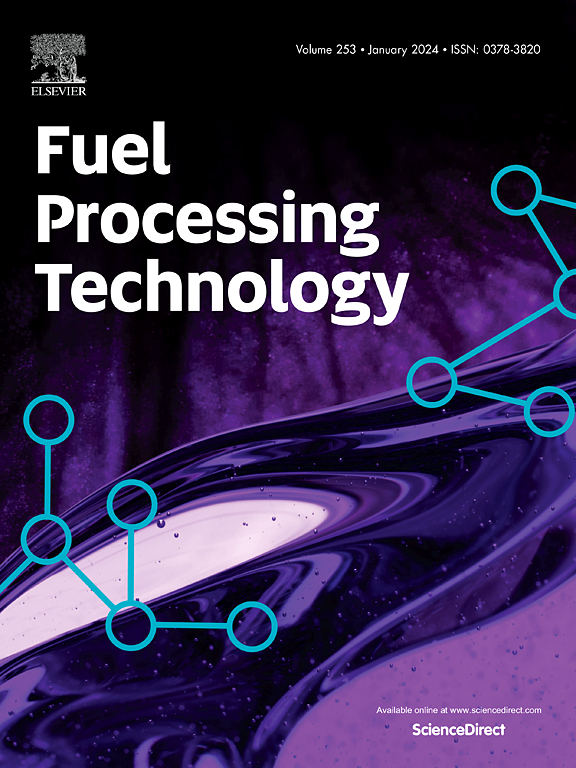Evolution of full-scale pore structure characteristics of long-flame coal and influencing factors
IF 7.7
2区 工程技术
Q1 CHEMISTRY, APPLIED
引用次数: 0
Abstract
China has vast long-flame coal reserves containing abundant coalbed methane (CBM) resources. Understanding the evolution of full-scale pore structure characteristics of this coal and their influencing factors are vital for the CBM development. However, researches on these topics are limited. Herein, 17 long-flame core coals were collected from southern Junggar Basin to accurately characterize the specific surface area (SSA), total pore volume (Vt), and full-scale pore size distribution (FPSD) using mercury intrusion porosimetry (MIP) along with N2/CO2 adsorption experiments. Results demonstrate that the FPSD generally exhibits a bimodal characteristic, with abundance of micropores and macropores but scarcity of mesopores, which hinders the efficient transport of CBM. The full-scale pore structure characteristics are closely linked to coal's thermal evolution. As Ro, max rises, Vt, mesopore volumes (Vme), and macropore volumes (Vma) initially decrease to a minimum at a Ro, max of ∼0.55 % and then increase. Conversely, micropore volumes (Vmi) exhibit an inverted U-type correlation with Ro, max, peaking almost at the same Ro, max. Ash yield negatively affects pore volumes and SSAs, particularly for macropores. Inertinite-rich long-flame coals, particularly those with higher semifusinite and fusinite contents, develop more micropores and mesopores, whereas increasing vitrinite content is negatively correlated with their development.
长焰煤全尺寸孔隙结构特征演化及影响因素
中国长焰煤储量巨大,蕴藏着丰富的煤层气资源。了解该煤全尺度孔隙结构特征演化及其影响因素对煤层气开发具有重要意义。然而,关于这些主题的研究是有限的。利用压汞孔隙法(MIP)和N2/CO2吸附实验,对准噶尔盆地南部17块长火焰岩心煤的比表面积(SSA)、总孔隙体积(Vt)和全孔径分布(FPSD)进行了准确表征。研究结果表明,该结构总体上呈现出微孔和大孔丰富而中孔较少的双峰特征,阻碍了煤层气的高效运移。全尺度孔隙结构特征与煤的热演化密切相关。随着Ro、max的升高,Vt、中孔体积(Vme)和大孔体积(Vma)在Ro时先减小到最小值,最大值为0.55%,然后增加。相反,微孔体积(Vmi)与Ro, max呈倒u型相关,几乎在相同的Ro, max处达到峰值。灰分产率对孔隙体积和ssa有负面影响,尤其是对大孔隙。长焰煤中微孔和介孔的发育与镜质组含量的增加呈负相关,尤其是半辉质组和辉质组含量较高的长焰煤。
本文章由计算机程序翻译,如有差异,请以英文原文为准。
求助全文
约1分钟内获得全文
求助全文
来源期刊

Fuel Processing Technology
工程技术-工程:化工
CiteScore
13.20
自引率
9.30%
发文量
398
审稿时长
26 days
期刊介绍:
Fuel Processing Technology (FPT) deals with the scientific and technological aspects of converting fossil and renewable resources to clean fuels, value-added chemicals, fuel-related advanced carbon materials and by-products. In addition to the traditional non-nuclear fossil fuels, biomass and wastes, papers on the integration of renewables such as solar and wind energy and energy storage into the fuel processing processes, as well as papers on the production and conversion of non-carbon-containing fuels such as hydrogen and ammonia, are also welcome. While chemical conversion is emphasized, papers on advanced physical conversion processes are also considered for publication in FPT. Papers on the fundamental aspects of fuel structure and properties will also be considered.
 求助内容:
求助内容: 应助结果提醒方式:
应助结果提醒方式:


